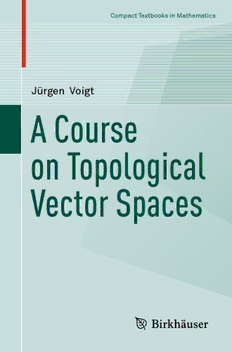
A course on topological vector spaces PDF
Preview A course on topological vector spaces
Compact Textbooks in Mathematics Jürgen Voigt A Course on Topological Vector Spaces CompactTextbooksinMathematics CompactTextbooksinMathematics This textbook series presents concise introductions to current topics in mathematicsandmainlyaddressesadvancedundergraduatesandmaster students. The concept is to offer small books covering subject matter equivalentto2-or3-hourlecturesorseminarswhicharealsosuitablefor self-study.Thebooksprovidestudentsandteacherswithnewperspectives andnovelapproaches. Theyfeatureexamplesandexercisestoillustrate keyconceptsandapplicationsofthetheoreticalcontents.Theseriesalso includes textbooks specifically speaking to the needs of students from otherdisciplinessuchasphysics,computerscience,engineering,lifesci- ences,finance. • compact:smallbookspresentingtherelevantknowledge • learningmadeeasy:examplesandexercisesillustratetheapplication ofthecontents • usefulforlecturers:eachtitlecanserveasbasisandguidelinefora semestercourse/lecture/seminarof2–3hoursperweek. More information about this series at http://www.springer.com/series/ 11225 Ju¨rgenVoigt A Course on Topological Vector Spaces Ju¨rgenVoigt InstitutfürAnalysis FakultätMathematik TechnischeUniversitätDresden Dresden,Germany ISSN2296-4568 ISSN2296-455X (electronic) CompactTextbooksinMathematics ISBN978-3-030-32944-0 ISBN978-3-030-32945-7 (eBook) https://doi.org/10.1007/978-3-030-32945-7 MathematicsSubjectClassification(2010):46A03,46-01,46A20,46A08,46A13 ©SpringerNatureSwitzerlandAG2020 Thisworkissubjecttocopyright.AllrightsarereservedbythePublisher,whetherthewhole orpartofthematerialisconcerned,specificallytherightsoftranslation,reprinting,reuse ofillustrations,recitation,broadcasting,reproductiononmicrofilmsorinanyotherphysical way,andtransmissionorinformationstorageandretrieval,electronicadaptation,computer software,orbysimilarordissimilarmethodologynowknownorhereafterdeveloped. Theuseofgeneraldescriptivenames,registerednames,trademarks,servicemarks,etc.inthis publicationdoesnotimply,evenintheabsenceofaspecificstatement,thatsuchnamesare exemptfromtherelevantprotectivelawsandregulationsandthereforefreeforgeneraluse. Thepublisher,theauthors,andtheeditorsaresafetoassumethattheadviceandinformation inthisbookarebelievedtobetrueandaccurateatthedateofpublication.Neitherthe publishernortheauthorsortheeditorsgiveawarranty,expressedorimplied,withrespect tothematerialcontainedhereinorforanyerrorsoromissionsthatmayhavebeenmade. Thepublisherremainsneutralwithregard tojurisdictionalclaimsinpublishedmapsand institutionalaffiliations. ThisbookispublishedundertheimprintBirkhäuser, www.birkhauser-science.combythe registeredcompanySpringerNatureSwitzerlandAG. Theregisteredcompanyaddressis:Gewerbestrasse11,6330Cham,Switzerland v Preface Thetheoryoftopologicalvectorspaces–asabranchoffunctionalanalysis, motivated by applications and pushed forward also for abstract reasons – was developed over a long period of time, say, starting in the 1940s, and adoptedinuniversitiesforteachinginthe1960s,whenitbecamemandatory foradvancedstudentsinanalysistoacquireknowledgeinthistopic.Itwas indeedinthelate1960sthatIattendedacourse,givenbythelateProf.W. Roelcke, University of Munich, on topological vector spaces and received myfundamentaleducationinthisarea.Whenworkinginpartialdifferential equations, operator theory, or some other topics in functional analysis, I alwaysappreciatedmyknowledgeinthisabstractpartoffunctionalanalysis, mainlyasasomehowalwayspresentbackground. It was in 2011, during discussions with some graduate students and youngcolleagues,thatIdiscoveredthattheydidnothave,andmissed,this kindofbackground–andinfactaskedhowtheyshouldhaveacquiredit,due tothelackofofferedcourses.ItwasthenthatIdecidedtoteachacourseon thistopic. Duetothenatureofthecourse,thebookiscertainlynotintendedtogive anexhaustivetreatmentofthetopic.Thebackgroundthereadershouldhave isthematerialpresentedinabasiccourseinfunctionalanalysis.Infact,the firsttwochaptersofthebookcontaintopicswhichmostlyhadbeentreated alreadyinmybasiccourseonfunctionalanalysis.Also,asseenimmediately fromthetableofcontents,thecourseisdirectedtowardthetheoryoflocally convexspaces. Theintendedmainobjectiveofthecoursewasthetreatmentoftopologies fordualpairs,fundamentalpropertiesofwhicharecontainedinChapters3 to 6 – but unavoidably dual pairs are always present in the theory of locally convex spaces. In particular, the introduction of polar topologies and the Mackey–Arens theorem can be considered as a minimal kernel for the treatment of dual pairs. The topics of Chapters 8 to 11, reflexivity, completeness, locally convex final topology including applications, and compactness,arestillprettystandardforthecourse. Having covered these basic topics, I decided to present a choice of resultswhichareofinterestevenforBanachspacesbutneedthetheoryof locallyconvexspaces.ThesearetheKrein–ŠmuliantheoreminChapter12, the Eberlein–Šmulian theorem in Chapter 13 and the theorem of Krein in Chapter 14. Having talked so much about weakly compact sets in Chapters 13 and 14, I used Chapter 15 to present an important nontrivial example, in the form of weakly compact sets in L -spaces. Finally, in 1 Chapter16,Ithoughtitofinteresttopresentanexamplewhereitispossible todeterminethebidualofalocallyconvexspaceforwhichonedoesnothave anexplicitrepresentationofthedual. vi Preface ThetopicsofChapter7,onFréchetspaces,andChapter17,theKrein– Milmantheorem,werenotpartoftheactualcourse. Clearly,inapresentationofresultsthathavebeendevelopedoveralong time,onecannotexpectmuchoriginality.Nevertheless,desiringtoproceed to interesting topics as fast as possible, I tried to present a streamlined approach, omitting many sidelines which might be interesting but not directly contributing to the aim I had in mind. According to my personal tastesinreading,Ipreferredaconcisestylewhereallneededingredientsare mentioned,butsomeactivecollaborationofthereaderisrequired. It may seem somewhat strange that I delegated the Hahn–Banach theorem and the uniform boundedness theorem to appendices. The reason isthatIconsideredthemasbelongingtotheprerequisitescoveredinabasic courseonfunctionalanalysis(andinfactinthecourseitself,theywerenot included). Atthebeginningofeachchapter,Igiveabriefoutlineoftopicstreated therein.InthenotesattheendofeachchapterItrytomentionthesources forthemainresults,sometimesaddingfurthercomments. Inanindexofnotationandanindex,thereadercanfindtheexplanation ofthesymbolsandoftheterminologyusedinthetext. Finally, I want to add acknowledgementsof various kinds. First of all, I want to thank the late Prof. Walter Roelcke for his introduction to the topic. Next, it is a pleasure to thank my colleagues and friends for many years from Munich times, Peter Dierolf and the late Susanne Dierolf, for many discussions and exchanges on various topics in the area as well as for the collaboration with Peter Dierolf. Finally, to come to more recent times,mythanksgotothelateProf.JohnHorváthforcommunicationonthe manuscriptandforencouragement.ItisapleasuretothankSaschaTrostorff, HendrikVogt,andMarcusWaurickformanydiscussionsonvarioustopics inthebook,andtoSaschaTrostorffandMarcusWaurickforreadingthefirst manuscript and discovering gaps, errors, and misprints. Also, I am much obliged to Dirk Werner for various comments on contents, examples, and misprints;inparticular,itwashissuggestiontoincludeachapteronFréchet spaces,becauseoftheirimportanceinanalysis. Andlastbutnotleast,alonganotherline,IthankmywifeMariannefor lifelongsupportandpatience. Dresden,Germany JürgenVoigt August2019 vii Contents 1 InitialTopology,TopologicalVectorSpaces, WeakTopology................................................... 1 2 Convexity,SeparationTheorems,LocallyConvexSpaces.... 11 3 Polars,BipolarTheorem,PolarTopologies .................... 23 4 TheTikhonovandAlaoglu–BourbakiTheorems.............. 29 5 TheMackey–ArensTheorem.................................... 37 6 TopologiesonE(cid:2)(cid:2),Quasi-barrelledandBarrelledSpaces.... 45 7 FréchetSpacesandDF-Spaces.................................. 53 8 Reflexivity ........................................................ 63 9 Completeness .................................................... 71 10 LocallyConvexFinalTopology,TopologyofD((cid:2))............ 81 11 Precompact–Compact–Complete ............................ 93 12 TheBanach–DieudonnéandKrein–ŠmulianTheorems ...... 97 13 TheEberlein–ŠmulianandEberlein–Grothendieck Theorems ......................................................... 103 14 Krein’sTheorem.................................................. 113 15 WeaklyCompactSetsinL1(μ).................................. 119 16 B(cid:2)(cid:2) =B............................................................ 125 0 17 TheKrein–MilmanTheorem..................................... 131 viii Contents A TheHahn–BanachTheorem..................................... 139 B Baire’sTheoremandtheUniformBoundednessTheorem.... 143 References................................................................. 147 IndexofNotation......................................................... 151 Index....................................................................... 153 1 1 Initial Topology, Topological Vector Spaces, Weak Topology Themainobjectiveofthischapteristopresentthedefinitionoftopologicalvectorspaces andtoderivesomefundamentalproperties.Wewillalsointroducedualpairsofvector spaces and the weak topology. We start the chapter by briefly recalling concepts of topologyandcontinuity,therebyalsofixingnotation. LetX beaset,τ ⊆ P(X)(thepowersetofX). Then τ iscalled atopology,and (X,τ)iscalledatopologicalspace,if (cid:2) foranyS ⊆τ onehas S∈(cid:3)τ, foranyfiniteF ⊆τ onehas F∈τ. (cid:2) (cid:3) (This definition is with the understanding that ∅ = ∅, ∅ = X, with the consequencethatalways∅,X∈τ.)Concerningnotation,wecouldalsowrite (cid:4) (cid:4) (cid:5) (cid:5) S = U, F = A. U∈S A∈F IfS = (Uι)ι∈I orF = (An)n∈N arefamilies ofsets, withN finite, thenonecan also write (cid:4)(cid:6) (cid:7) (cid:4) (cid:5)(cid:6) (cid:7) (cid:5) U ; ι∈I = U, A ; n∈N = A . ι ι n n ι∈I n∈N ThesetsU ∈τ arecalledopen,whereasasetA ⊆ X iscalledclosedifX\Ais open.ForasetB ⊆Xwedefine (cid:2) ◦ B (=intB):= {U; U∈τ, U ⊆B},theinteriorofB (anopenset), (cid:3) B (=clB):= {A; A⊇B, Aclosed},theclosureofB (aclosedset). ©SpringerNatureSwitzerlandAG2020 J.Voigt,ACourseonTopologicalVectorSpaces,CompactTextbooksinMathematics, https://doi.org/10.1007/978-3-030-32945-7_1
